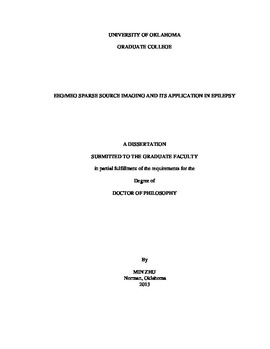| dc.contributor.advisor | Ding, Lei | |
| dc.contributor.author | Zhu, Min | |
| dc.date.accessioned | 2013-12-16T18:02:02Z | |
| dc.date.available | 2013-12-16T18:02:02Z | |
| dc.date.issued | 2013-12-13 | |
| dc.identifier.uri | https://hdl.handle.net/11244/7905 | |
| dc.description.abstract | This dissertation is a summary of my Ph.D. work on the development of sparse source imaging technologies based on electroencephalography (EEG) and magneto-encephalography (MEG) and their application to noninvasively reconstruct brain activation from external surface measurements. Conventional sparse source imaging (SSI) methods using the ℓ1-norm regularization to enforce sparseness in the original source domain leads to over-focused solutions and causes bias in estimating spatially extended brain sources. I address the over-focused issue in the ℓ1-norm regularization technique framework by exploring sparseness in the transform domains. First, I apply a SSI method that uses the variation transform, i.e. V-SSI, on clinical MEG interictal recordings from partial epilepsy patients. Estimated epileptic sources by V-SSI are validated using clinical pre-surgical evaluation data and surgical outcomes. Second, I implement a novel face-based wavelet transform, which can efficiently compress brain activation signals into sparse representations on a multi-resolution cortical source model, into the SSI technology framework. The proposed wavelet-based SSI (W-SSI) demonstrates a significantly improved ability in inferring both brain source locations and extents as compared with conventional ℓ2-norm regularizations in obtaining EEG/MEG inverse solutions and other SSI technologies. Furthermore, the face-based wavelet also indicates better performance than a previously reported vertex-based wavelet in W-SSI. I evaluate the W-SSI method and conduct the comparison studies using both simulations and real data collected from partial epilepsy patients. Lastly, I further propose the concept of using multiple transforms in the SSI technology framework and investigated a new SSI method by enforcing sparseness in both variation and face-based wavelet domains, termed as VW-SSI. I conduct simulation studies, which demonstrate that VW-SSI has significantly better detection accuracies in both source locations and extents than conventional ℓ2-norm regularizations and other SSI methods, including SSI, V-SSI, and W-SSI. I further validate the VW-SSI method using clinical MEG data from both language and motor experiments collected from epilepsy patients again to localize their important functional brain areas. The results indicate that VW-SSI provides a performance advantage in detecting neural phenomena that have been extremely difficult to recognize by other EEG/MEG inverse solutions. It thus suggests that the sparse source imaging technique is promising to serve as a non-invasive tool in assisting pre-surgical planning for partial epilepsy patients. | en_US |
| dc.language | en_US | en_US |
| dc.subject | Engineering, Electronics and Electrical. | en_US |
| dc.title | EEG/MEG Sparse Source Imaging and Its Application in Epilepsy | en_US |
| dc.contributor.committeeMember | Ding, Lei | |
| dc.contributor.committeeMember | Zhu, Meijun | |
| dc.contributor.committeeMember | Fagg, Andrew | |
| dc.contributor.committeeMember | Havlicek, Joseph | |
| dc.contributor.committeeMember | Liu, Hong | |
| dc.date.manuscript | 2013-12-13 | |
| dc.thesis.degree | Ph.D. | en_US |
| ou.group | College of Engineering::School of Electrical and Computer Engineering | |
